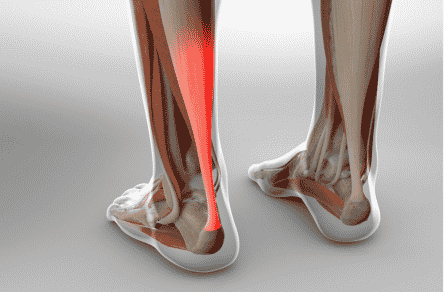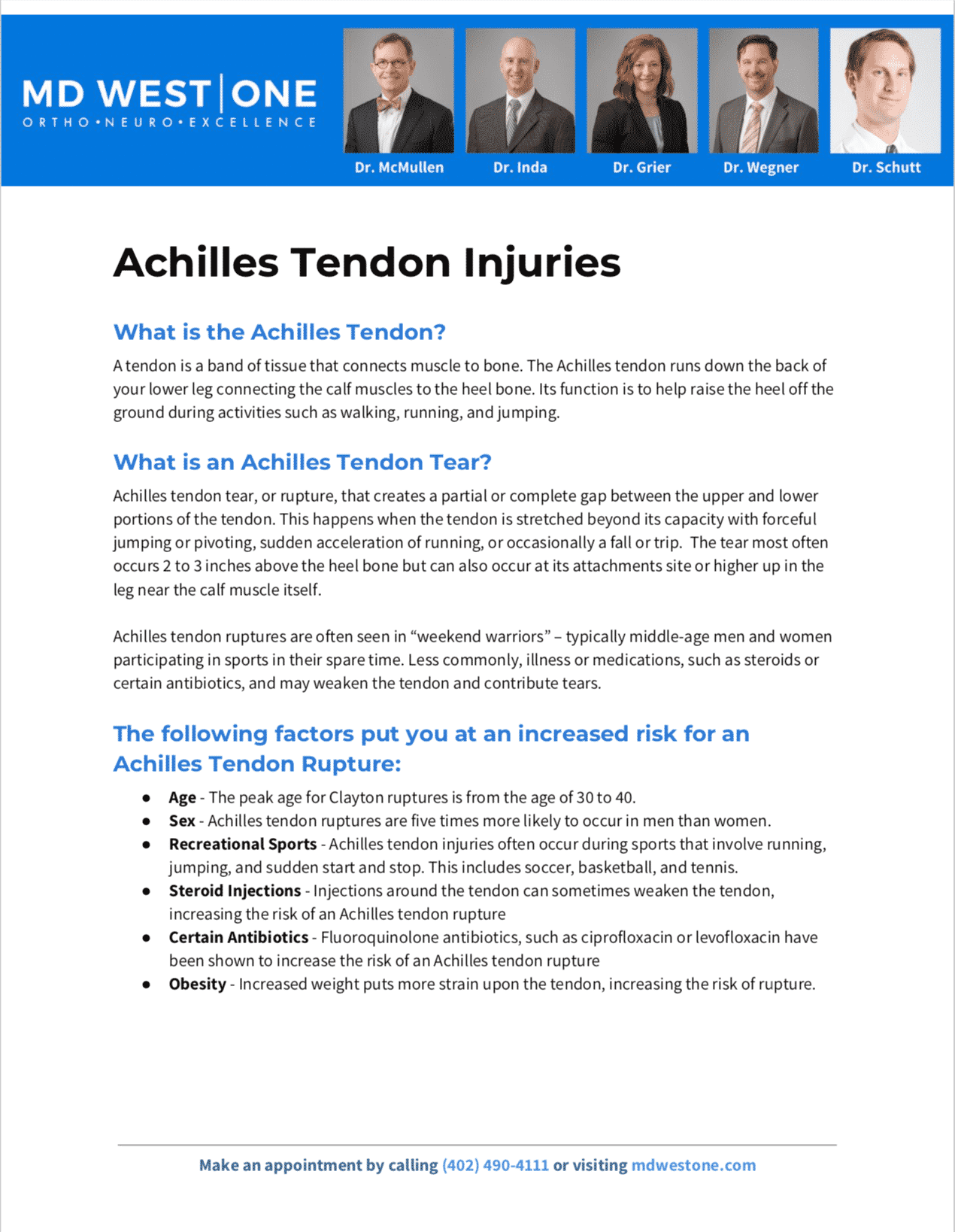Achilles Tendon Lengthening Procedure
An Achilles tendon lengthening procedure is a surgery that stretches the Achilles tendon to make it longer. This large tendon connects the calf muscles to the heel which enables you to lift your foot off the ground when you are walking. When the Achilles tendon is too short, it causes pain and problems with walking or movement.
Symptoms
The Omaha Foot & Ankle Specialists at MD West ONE are able to properly diagnose the condition, Achilles contracture, which may lead to an Achilles tendon lengthening procedure. If you have the following symptoms, you may want to make an appointment with one of our Board Certified Specialists.
- Poor posture
- Extensive pain in the Achilles tendon
- Experiencing discomfort in the back of feet/heels
- Foot remaining in a bent position causing flat foot, forcing the knees to bend
- Stiff foot muscles otherwise
- Toes positioned abnormally

Why is an Achilles Tendon Lengthening Procedure Performed?
Achilles Tendon Lengthening (ATL) Surgery is sometimes performed to correct muscle spasticity, or the abnormal increase in muscle tone or stiffness of muscle. It is primarily used to improve an inability to walk or stand due to a condition called Achilles contracture.
There is not one single explanation for Achilles contracture. Some conditions associated with it are:
- Genetics/birth abnormality
- Diabetes-related deformity or clubfoot
- Cerebral palsy
- Chronic tendinitis
- Spinal cord injury
- Stroke
Surgical Procedure
To begin the procedure, you are put under anesthesia or given medicine to make you feel relaxed and numb. Then the lengthening process begins by making some small surgical incisions on the back of your ankle along the sides of your Achilles tendon. From there, the surgeon may use one of a few different methods to complete the procedure. These methods include:
Percutaneous Method
During this procedure, your doctor punctures the outside of the skin. This puncture creates tears in the tendon, which relieves tension on the cord. As the tendon heals, it retains length, resulting in less overall tension on the muscle.
Gastrocnemius Recession
This procedure loosens muscle fibers bound to the cord. The surgeon clips the gastrocnemius muscle (at the back of the leg), which helps elongate the tendon. It is usually for mild Achilles tension. It can be performed with an intramuscular implant, or with noninvasive endoscopic surgery.
Z-Plasty
This procedure allows for the greatest control over tendon size. A surgeon creates a Z-shapes series of cuts in the tendon and stretches it to a predetermined length. Then they join the tendon back together.
Risks Associated with Achilles Tendon Lengthening Procedure
All treatments whether surgical or non-surgical are subject to a degree of risk. A brief overview of risks associated with ATL procedures includes:
- Severing of the tendon during or after surgery
- Damage may prevent blood flow to the tendon
- Longer recovery time
- An over-lengthened tendon can create too much weight on your foot.
- Pressure injuries can form during the time
- The tendon may not loosen after surgery
- Severing of the tendon during or after surgery
- Additional surgery to correct complications
Post Operative Care
After an Achilles tendon lengthening procedure, you will need to wear a cast, walking boot, or splint for 6-8 weeks in order to prevent your foot from moving while it heals. Each person's recovery can be different but you will be given instructions for activities to avoid for 6 to 8 weeks after surgery which will let you know when it is okay to put weight on your foot that had the procedure.
After the instructed limited movement in the first 6-8 weeks, physical therapy may be required once the cast, walking boot, or splint is removed. A physical therapist can help you strengthen your healing ankle and improve mobility and flexibility.
How can you care for yourself at home?
Activity Level After Surgery
- Rest when you feel tired and get enough sleep
- Wear a cast or walking boot that keeps your foot and ankle from moving for 6 to 12 weeks after surgery
- Use crutches to move around the house to do daily tasks and do not put weight on the leg
- If your doctor says it's okay, you may shower 24 to 48 hours after surgery. Be sure to keep the bandage and area dry when doing so.
- Do not take a bath, swim, use a hot tub, or soak your leg until your doctor says it is okay.
- You can drive when you can move and control your foot and ankle, you are no longer using crutches, and you are no longer taking prescription pain medicine. This usually takes 4 to 6 weeks.
- The activity level of your job depends on how soon you will be able to return to work. If you sit at work, you may be able to go back in 1 to 2 weeks. But if you are on your feet at work, it may take 6 to 8 weeks.
Incision Care
- If you have a bandage over your incision, keep the bandage clean and dry. Follow your doctor's instructions. Your doctor will probably want you to leave the bandage on until you are seen in the office. If your doctor allows it, you may be able to remove the bandage 48 to 72 hours after your surgery.
- If you have strips of tape on the incision, leave the tape on for a week or until it falls off. Keep the area clean and dry.
- If you have a splint or cast, follow your doctor's instructions. Keep it dry. Do not put anything, including powder, between the splint or cast and your skin.
Ice and elevation
- To reduce swelling and pain, put ice or a cold pack on your leg for 10 to 20 minutes at a time. Do this every few hours. Put a thin cloth between the ice and your skin.
- Prop up the sore leg on a pillow when you ice it or anytime you sit or lie down for 3 days after surgery. Try to keep it above the level of your heart. This will help reduce swelling.
- If your doctor gave you support stockings, wear them as long as instructed. These help to prevent blood clots.
When should you call for help during the post-op process?
Call 911 anytime you think you may need emergency care. For example, call if:
- You lost consciousness
- You have chest pain, are short of breath, or you cough up blood
Call your doctor or nurse call line now or seek immediate medical care if you have any of the following:
- Pain that does not get better after you take pain medicine
- Tingling, weakness, or numbness in your foot or toes
- Your cast or splint feels too tight
- Your foot is cool or pale or changes color
- Feel sick to your stomach or cannot drink fluids
- Loose stitches, or your incision comes open
- Pain in your calf, back of the knee, thigh, or groin
- Redness or swelling in your leg
- Increased pain, swelling, warmth, or redness
- Red streaks leading from the incision
- Pus draining from the incision
- A fever
- You bleed through your bandage
Meet MD West ONE's foot and ankle specialists and learn more about how they treat Achilles tendon injury.
AMERICAN ORTHOPAEDIC FOOT & ANKLE SOCIETY
All of the foot and ankle surgeons in the practice are recognized members of the American Orthopaedic Foot & Ankle Society. It is the oldest and most prestigious medical society dedicated to the foot and ankle. The mission of the society is to advance science and practice of foot and ankle surgery through education, research, and advocacy on behalf of patients and practitioners. These physicians dedicate their time and energy to improving the patient experience and their knowledge in their field. For more information visit http://www.aofas.org.
MD West ONE Foot & Ankle Specialists:
The Foot & Ankle Specialists are all Board Certified and Fellowship-Trained, meaning they’ve focused their education, training and research on orthopaedic surgery of the foot and ankle.





